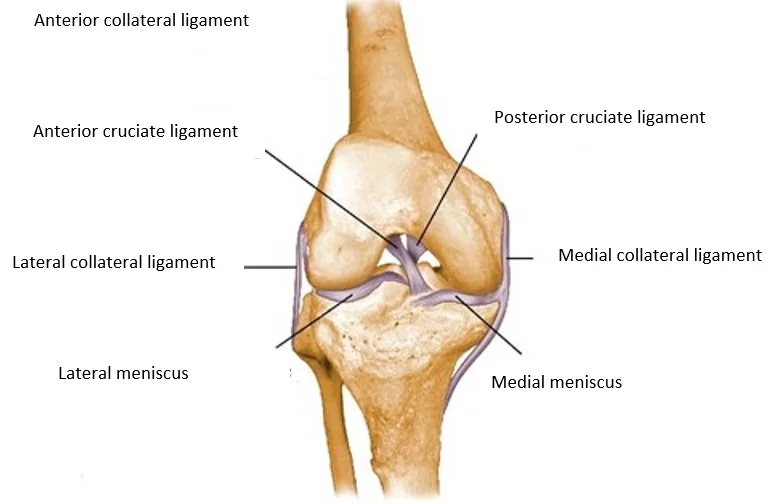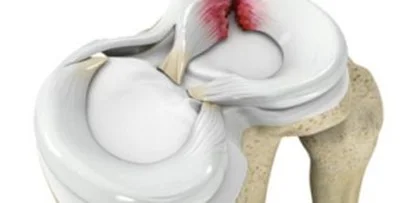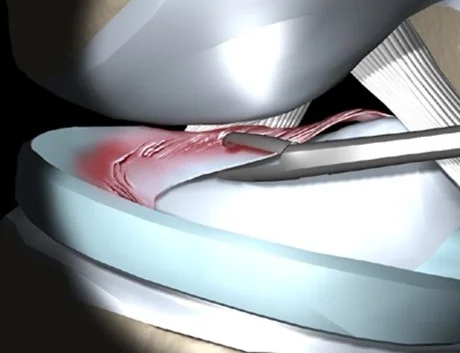This is how our application simplifies the booking and administration process. Interested >>
Knee cartilage surgery
A surgery is necessary if the ring shaped, semilunar knee cartilage (meniscus) is damaged because this injury does not recover with conservative treatment.

What is the ring shaped, semilunar knee cartilage (meniscus)?
The knee joint has one of the most complex structures in the human body. The structure of the knee joint allows it to contribute to multiple lower limb movements. There are two ring shaped, semilunar cartilages (menisci) between the thighbone and the shinbone. These consist of fibrous cartilage, and they are the shock absorbers of the knee joint. The knee cartilages play an important role in knee movements because they balance the difference in the curves of the bone ends of the thighbone and the shinbone, which form the knee joint. The knee joint may get injured during numerous different movements, which most often happen during sport, recreational activities, or work. This may of course happen on the basis of degeneration, the so called “tissue wear” too. Sometimes, a knee cartilage injury may not cause any symptoms, but in the majority of the cases, the knee and the movements become painful, so the function of the joint may get damaged.
General information about knee cartilage (meniscus) injuries
Knee cartilage (meniscus) injuries occur most commonly during twisting movements of the knee. This could be the result of one major, or multiple minor injuries. A cyst may develop from the weakened fibers of the injured meniscus; this may also lead to symptoms in the knee joint. It is common that the cause of the injury is knee instability, or axis deviation (X leg, O leg). The detached pieces of the knee cartilage may get obstructed between the thighbone and the shinbone during movements, which may be accompanied by expressed pain, and the knee flexion and extension may be limited. In many cases, the detached flap may rotate outward and inward within the two joint surfaces, and sometimes it produces symptoms in the knee, but sometimes it does not, so very often the detection of the problem is delayed. Usually, the repeated obstruction of the cartilage piece is accompanied by sharp pain, and the feeling of obstruction. If the injured cartilage pieces are not treated in time, they will wear down the joint surfaces by moving constantly, which may lead to cartilage wear (arthrosis) over time. The aim of the surgical intervention is to make the knee painless, protect the joint surfaces from potential additional damages, and to prevent cartilage wear, which will occur over time.
Which are the potential symptoms?
The following are the most common symptoms of a knee cartilage tear, which may occur with other knee joint injuries:
- Swelling
- Pain
- Limited range of motion in the joint
- Obstructions
Specific symptoms of a knee cartilage tear are the following:
- Difficulty in extending and flexing the knee joint
- Variable knee joint symptoms (alternating periods of a painful and a painless state)
- Pain at the outer/inner surface of the knee

What treatment options are available for a knee cartilage tear?
Basically, there are two types of treatment options available. Conservative (non surgical) and surgical treatment.
The aim of conservative treatment
The main goal of the treatments is to achieve a painless condition, and to restore the range of motion of the knee. Unfortunately, a torn knee cartilage does not heal with conservative treatment, so it is quite common that the pain, and the knee joint’s reduced range of motion do not resolve. It should also be expected that the joint wear of the knee will increase with time, which in years, may result in a knee joint that is painful and difficult to use even in everyday life. Therefore, the surgical treatment of the damaged knee cartilage is recommended, if possible, instead of conservative treatment.
Conservative treatment methods
In case of an obstructed knee, it is necessary to elevate, and cool (icing, gel ice packs) the injured limb, and not to put any weight on it. Please do not continue doing sports. Fluid retention may develop in the joint as a consequence of the tear, and the knee may swell up. Pharmacological treatment, using painkillers, and anti inflammatory drugs, physiotherapy, and other methods of physical therapy are all parts of conservative treatment.
Surgical treatment
Knee cartilage injuries are treated with a minimal invasive arthroscopic method, through small incisions. The advantage of an arthroscopic intervention is that it is less demanding than an open surgery, so the pain after the surgery is less intense, and the duration of recovery is shorter too. The treatment of knee cartilage tears is mainly surgical because we try to prevent the previously mentioned complications. It is ideal to perform the surgery as soon as possible after the injury, even if it does not cause serious symptoms; this way, the joint surfaces and the knee cartilage can be protected from additional damages. The surgery is performed in general anesthesia (narcosis). The aim of the arthroscopic surgery is to remove the damaged piece by sparing as much healthy knee cartilage as possible. Once the damaged bits are removed, the cartilage will become smaller, but the joint will still be able to perform basic functions, unless the extent of the damage is not too large. Only two to three small cuts will be visible on the knee after the arthroscopic surgery. Recovery heavily depends on the surgical findings, concurrent injuries, and the postoperative treatment which is supported by physiotherapists.
Antibiotic and pathological coagulation prevention is used during surgery, if necessary, which should be continued at home in some cases. Additionally, it is necessary to perform the practiced physiotherapy exercises, and to rest the operated limb at home in accordance with the instructions of the physician, who performed the surgery.
Usually, non-weight bearing is not necessary after the intervention. In non problematic cases, the patients are discharged home on the first day after surgery. Anticoagulation should be applied for a determined period of time after surgery, which could be administered by the patient too. It could happen during surgery that an extensive knee cartilage injury is revealed, which may necessitate further surgeries.
The surgical process
During the surgery, two to three cuts of 1 cm are made on both sides of the knee, so that the arthroscope and the special arthroscopic devices could be inserted into the knee joint.
During the intervention, the damaged part of the knee cartilage is removed with a small pair of scissors through the tiny hole, and any potential cartilage surface injuries are smoothed out.
The area is rinsed, so that the inflammatory fluids and debris are removed. A small drain is inserted into the wound, if necessary, which will remove the blood and plasma that will accumulate after the surgery.
Elastic bandage is applied on the operated upper limb after the surgery.

What happens if the justified surgical treatment is not performed?
The damaging of the knee cartilage and the joint surfaces may continue, making the pain and the feeling of obstruction in the knee more intense. The cartilage surface of the joint may get damaged by the mobile cartilage pieces, which may lead to joint wear (arthrosis) in the long term. This process is irreversible, and it may result in a very painful joint with reduced range of motion, which could only be managed by surgery.
When can you return to your everyday activities?
Sedentary work usually can be started 1 3 weeks after surgery, but physical labor can only be started 6 weeks after the intervention. When it comes to sports, the patient can start using a stationary bike after 5 10 days, swimming could be started after 2 3 weeks and jogging after 3 4 weeks provided that the wound has healed. In order to achieve full recovery, other sports (football, basketball, etc.), and skiing can only be started after 4 6 weeks.
If you have any questions, please send a letter to magankorhaz@bhc.hu!





